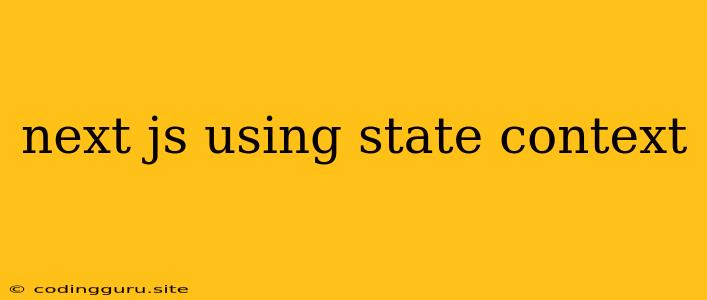Mastering State Management in Next.js with Context API
Next.js, a popular React framework, provides developers with a robust set of tools for building performant and scalable web applications. However, managing state across different components can pose a challenge, especially in complex applications. This is where the Context API comes in, offering a clean and efficient way to share data and functionality throughout your Next.js project.
Why Context API?
The Context API is a built-in feature of React that allows you to create a global state container. It effectively acts as a centralized store for your application's data. Let's explore the key advantages of using the Context API in Next.js:
- Simplified State Management: No more relying on complex prop drilling to pass data down component hierarchies. With Context, state becomes accessible globally within your application, eliminating the need for repetitive data passing.
- Improved Code Organization: The Context API promotes a cleaner and more organized codebase. By separating state logic from component logic, you enhance maintainability and reduce the potential for errors.
- Enhanced Reusability: Context API allows you to easily share and reuse state across multiple components, fostering modularity and flexibility within your project.
Creating Your First Context
Let's dive into a practical example to demonstrate how to create and utilize a Context in your Next.js application:
import React, { createContext, useContext, useState } from 'react';
// Create the Context
const ThemeContext = createContext();
// Define the Provider Component
const ThemeProvider = ({ children }) => {
const [theme, setTheme] = useState('light');
const toggleTheme = () => {
setTheme(prevTheme => (prevTheme === 'light' ? 'dark' : 'light'));
};
return (
{children}
);
};
// Define a Custom Hook for accessing the Context
const useTheme = () => useContext(ThemeContext);
export { ThemeContext, ThemeProvider, useTheme };
In this code snippet:
- We define a
ThemeContextusingcreateContext. - The
ThemeProvidercomponent houses the state (theme) and a function (toggleTheme) to modify it. - We wrap our application's components with
ThemeProviderto provide access to the context. - The
useThemehook simplifies using the context within components.
Using the Context in Components
Now, let's see how to access the context within our Next.js components:
import React from 'react';
import { useTheme } from '../context/ThemeContext';
const MyComponent = () => {
const { theme, toggleTheme } = useTheme();
return (
My Component
);
};
export default MyComponent;
In this example:
- We import
useThemefrom our context file. - We use the hook to access the
themeandtoggleThemevalues from theThemeContext. - We can now use the state and functionality within our component.
Implementing Global State Management
While the Context API is powerful, for more complex state management scenarios, you might want to consider a dedicated state management library like Redux, Zustand, or Recoil. These libraries offer features like:
- Centralized State: A single store for your application's state.
- Predictable State Updates: Well-defined actions and reducers for modifying state.
- Time Travel Debugging: Inspecting previous state changes for easier debugging.
When to Choose the Context API
The Context API is an excellent solution for managing relatively simple state in Next.js applications. Here's when it's an ideal choice:
- Small to Medium-Sized Projects: For projects with a limited number of components and manageable state complexity.
- Sharing Global State: When you need to share data and functionality across components, like themes, user authentication, or application settings.
- Direct Access to State: When you want components to directly access and modify the state without relying on complex prop passing.
Conclusion
The Context API provides a robust and convenient way to handle state within Next.js applications. It simplifies data sharing, improves code organization, and enhances reusability. When combined with best practices and potentially augmented with state management libraries for larger projects, the Context API empowers developers to build dynamic and maintainable Next.js applications.
